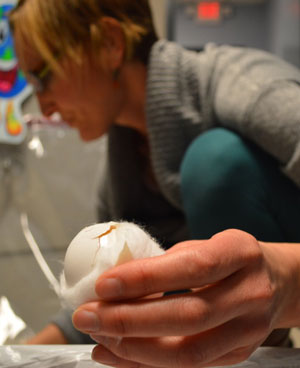At STARBASE Battle Creek, located on the Air National Guard Base, the four-girl team of Page Elementary fifth-graders knew the landing was a one-shot event. Survival with bruises, bumps and cracks was okay, but oozing any kind of liquid — not so much.
The girls — Raini Braska, Emma Gibson, Lydia Schilthroat and Kateri Webster — formed the team known as Alpha, the first code word in the international phonetic alphabet. Team Alpha swaddled a raw egg in fluffy cotton balls, wrapped with a coffee filter and secured with a wisp of masking tape.

Once the egg-passenger was nestled into the toy-size wooden space shuttle, the pilot Emma Gibson handed it to STARBASE instructor Bruce Medaugh, who was standing on a ladder to mount the shuttle on the zipline. Team Alpha crowded around the landing strip, with Emma standing next to certified Michigan teacher Amy Wright.
“We’re going to count down from three,” Wright called out. “Ready? Three, two, one, launch!”
As the egg careened toward Eggbert’s Crash Landing, teacher Curt Wissink’s fifth-graders eagerly watched the action with a palpable but unspoken ebullience. The shuttle’s crash boomed out a loud wallop that elicited cheers. “Oh! It hits pretty hard,” observed Raini.
Wright removed the egg from the restraint, warning the students that an oozing egg “died” on impact.
“This is looking promising,” Wright said as she cut through the protective padding. “Okay, this egg has a sad face but it looks like a survivor. Not a dent, crack or anything on this egg. Good job, ladies.”

Real-world Learning
At STARBASE, science education is something that you do. It is a U.S. Department of Defense-sponsored program delving into the excitement of science, technology, engineering and math (STEM) with hands-on activities and experiments. Battle Creek is one of 66 STARBASE sites across the U.S. and Puerto Rico.
STARBASE is an educational enrichment program primarily serving fifth-graders. It began in 1989 at Selfridge Air National Guard Base in Michigan to address critical problems facing America’s youth, including math and science illiteracy and drug abuse.
In 1991 with a three-year grant from the W. K. Kellogg Foundation, the program provided math and science activities, goal-setting skills, and drug education. U.S. Senator Carl Levin of Michigan and Senator Sam Nunn of Georgia presented STARBASE to Congress for Department of Defense funding, which was approved in 1993.
For five hours one day a week for five weeks, the Page Elementary fifth-graders hit the ground running from one project-based activity to the next. The school pays for the buses to transport their students to the Battle Creek Air National Guard Base.
There, they perform STEM projects and experiments in aviation and space-related fields, their experiences reinforced in classroom lessons back home. The current session wraps up Feb. 8, and the next one runs March 19 to April 24.
Two classrooms of nearly 60 students recently rotated through a 3-D computer-aided design assignment to Newton’s laws of motion, engineering design and physics, concluding with a visit to the fire station on the base at W.K. Kellogg Airport.

Touchdown, Launch and Landing
Back at the egg shuttle, instructor Wright called the boys of Team Bravo — Ethan Teachout, Spencer Ybema and Connor Dombkowski — to the flight deck, ready to launch the next fragile cargo. But the shuttle struggled to catapult down the zipline as its padding exerted friction, stopping the aircraft in its tracks. Once the boys got the shuttle moving along, though, it exploded the egg upon landing.
After Case Shellenbarger’s team also crashed and cracked up, Case wanted a second try. “If we could do this again, then we could cushion it differently,” Case said.
Bruce Medaugh’s A-OK with that failure to launch, as failure is a wonderful way to teach STEM, he says. Medaugh and fellow STARBASE instructor Darrick Gregory ask more of the students: more focus, more achievement, more creativity, more doing. Even snack time is called “brain break.” Students practice reciting the international phonetic alphabet from Alpha to Zulu, or explore the three properties of air.
“We’re basically doing one thing: We’re teaching the kids how to apply knowledge,” said Gregory. Also a Cooper Township Fire Department firefighter, he demonstrated the science of fire dynamics, using technology to measure and record data, math to analyze it and engineering for firefighting.
Teachers Curt Wissink and Josh Reynolds find that STARBASE’s fast-paced, ambitious curriculum keeps the students focused and engaged with nary a dull moment.
“Sparking curiosity is the best way to teach STEM,” Reynolds said. “I had a couple of students that I was worried about but they’re doing just fine here.”
On this particular day, at least one fifth-grader relished turning a theory into reality. Said Bradley Moerman, “This is so cool.”
CONNECT













